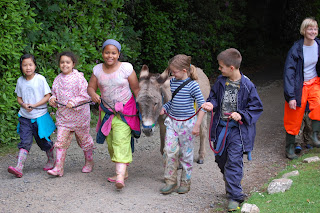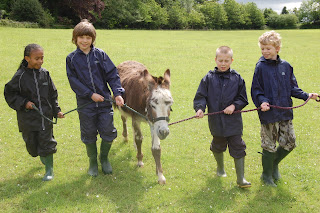As you may
know, Farms for City Children is our charity for 2012.
Founded by
children’s author Michael Morpurgo and his wife Clare at Nethercott Farm in
Devon in 1976, Farms
for City Children has since seen 75,000 children aged 9 to 11 take
part in its programmes. During the last school year (2010-2011), 2,843
children stayed for 7 days each.
We interviewed
their chief executive, Helen Chaloner, to find out more…
Why is the charity so important for
children?
 |
| Heavy lifting at Wick Court, Gloucestershire |
“It’s a
rounded experience which enables them to learn through doing. Children work together in teams and are immersed
in a completely different environment for seven days - deep in the countryside,
with stars in the night sky.”
“They learn
the farming way of life, which is round the clock and far removed from their
daily lives of TV, mobile phones and computers – they get none of that on our
farms. They don’t need it, and we find that they don’t miss it. They interact
with each other, sit down to meals together and support each other.”
“The
children learn things linked with the National Curriculum, like maths, science,
biology and history, and they also learn about themselves – recognising that
they are people and citizens. By looking after animals they become responsible
for another living being. Non-academic kids get the chance to shine and develop
their leadership qualities.”
So what does a typical stay on the
farm involve?
 |
| Lambing at Treginnis Iraf, Pembrokeshire |
“Children come
as a class with their teachers, and are provided with a carefully constructed
list of jobs throughout their stay. They start work early, at 7:30am, and they
could be in the dairy for milking and mucking out, or helping with a stock
check of sheep, collecting eggs or mucking out donkeys, pigs and hens.”
“They get a
cooked breakfast every day at 9am – something warm and hearty like bacon and
eggs, pancakes or porridge. Then it’s off to do another job at 9:45am. They get
some free time from 11:30 until the main meal of the day at 12:30pm. They eat
very well - the farms have big kitchen gardens, so children always have fresh vegetables
and meat. Most food is from farm to plate – which gives children a real
appreciation of where food comes from.”
“Another
job in the afternoon is followed by a light tea and then a final job at 6pm. It’s
a busy day – closely following our learning by doing philosophy. The children actually
love mud and rain and dirt and wind, and are physically worn out as they muck
in together. We have lots of good role models on the farm to influence the
children.”
But it’s not all hard work?
 |
| Donkey Walks at Nethercott, Devon |
“Not at
all. In the evening, children are treated to cocoa and cake and spend time with
their teachers, taking part in talent shows, storytelling, reading in the library,
or playing table football and ping pong. Once a week the children work with
local artists and craftsmen, who come in and spend an afternoon teaching them skills
likewillow weaving, making charcoal, carving and wire sculpture. We let the children
experience using tools, making sure they do it properly and carefully.”
Tell us about your illustrious
founder and the early days?
“Michael
Morpurgo used to read to the children a lot, and the poet Ted Hughes was
involved early on with his wife, Carol. Illustrator Quentin Blake was another
who has worked with us, to help bring out the creative streak in children –
you’ll see his lovely illustrations all over our website and in our marketing
material.”
“Michael is
still a trustee, an actively involved board member and a high-profile
ambassador for the charity. We’re also incredibly lucky and honoured to have
Princess Anne as our patron.”
Has the formula changed much over
the years?
 |
| More Donkey Walks at Nethercott |
“Not
really. The model has lasted incredibly well. We experimented with different
lengths of stay and group sizes early on, and found that a seven day stay,
Friday to Friday, works best. We’ve moved with the times to incorporate healthy
eating and physical exercise, providing an alternative to
convenience foods, obesity and sedentary TV lifestyles.”
And what plans for the future?
“We’re
looking for a fourth farm in the north of England. Our existing farms have been
fully booked for three years now, so there is a need for expansion. We’ve been
talking to the National Trust and there are a few possibilities but nothing
concrete yet. We have time to plan and wait for the right one.”
So who qualifies to come on a farm
stay and how does it get organised?
“We
prioritise our marketing at schools from inner cities and disadvantaged areas,
but children can come from any town or city, any urban environment. Children
always come with their school, so they should contact the farm they wish to
visit for availability. We’re open all year round, and often winter is just as
good as summer - what it lacks in sunshine it more than makes up for in terms
of farm activities and events and all the animals are kept in their barns, so
there is much more opportunity for interaction.”


















